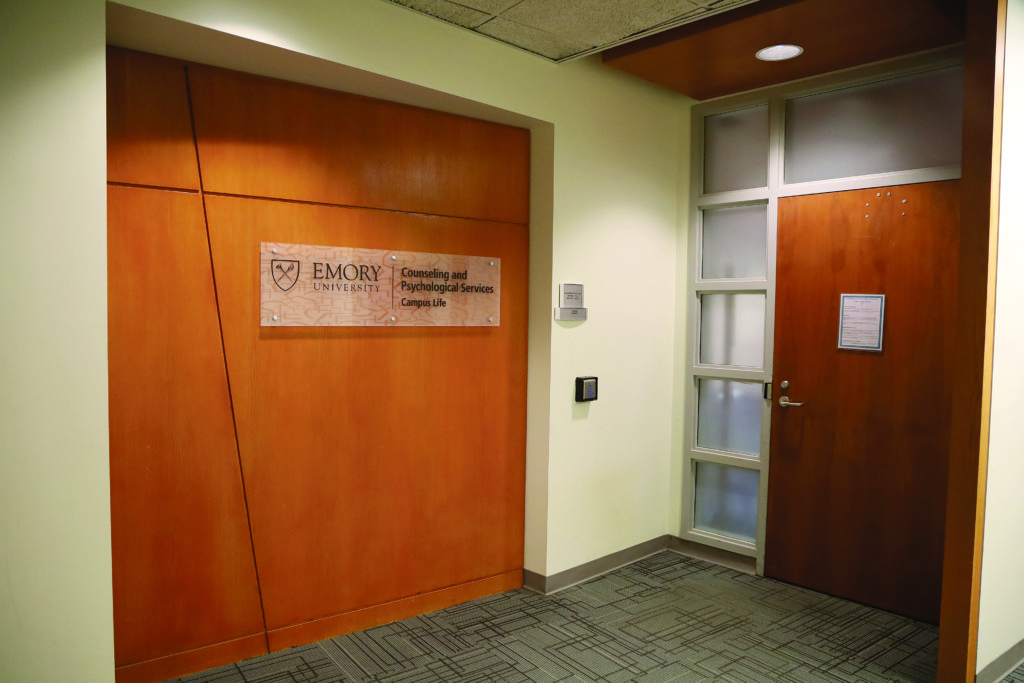Posted on 08 July 2022.
For Saima Nezami (25C), counseling and mental health services were completely new. As someone who had previously given little thought to her mental health, Nezami’s first time receiving counseling was with Emory University’s Counseling and Psychological Services (CAPS).
Nezami was relieved to be able to choose her counselor — a therapist who shared the same racial experiences and was able to empathize with her. Additionally, she expressed satisfaction with the quality of her sessions: Nezami’s counselor tried to verbally assist with any issues she was going through and was not quick to simply “diagnose and be done.”
“I would have sessions with her in the car, during break and at work,” Nezami said. “It was really interesting for me, because we would have sessions at 1 p.m., which is a really busy time for me. But I made it work, and I never skipped a single session.”
Upon concluding her CAPS sessions, which lasted for eight weeks due to the eight-session limit, Nezami’s CAPS therapist redirected her to TimelyCare — the standard protocol for CAPS counselors — which offers 12 sessions of virtual, 24/7 telehealth service for Emory students. However, TimelyCare did not offer the freedom for her to select a counselor.
“She also recommended that I look for a therapist in the area,” Nezami said. “That would be super expensive, and that’s a really big downside for students who need that ongoing support.”
Overall, Nezami reported that her time with CAPS was helpful and that she didn’t experience any major issues with the service, especially for her first encounter with counseling.

Emory Counseling and Psychological Services. (The Emory Wheel/Grace Shen, Contributing)
Other students on campus haven’t been so lucky. From month-long wait times to the unresponsiveness and inaccessibility of CAPS services, some students contend that the University’s response to their demands has been inadequate.
Seats At The Table Co-Founder Rebecca Schwartz’s (24C) personal experience with CAPS inspired her to start the student-run non-profit organization, which empowers college students to advocate for policies that promote mental wellness on campus.
Schwartz reached out to CAPS while she was experiencing a mental health crisis due to a non-school event that took a tremendous toll on her mental health. Though CAPS helped her acquire time out of classes and an extension on an exam, they also told Schwartz that CAPS is not meant to help with serious life events.
“They said that they really only felt equipped to help students with school-related stress,” Schwartz added.
Schwartz said that the hardest part about attending Emory is seldom the academics or anything related to the University at all. Rather, it’s the fact that students can experience hardships such as financial instability or loss of a family member while trying to get their degree.
According to Schwartz, Seats At The Table is a coalition of students who saw a problem at Emory that was continuing to go unsolved, including excessive wait times, lack of awareness of mental health resources, inability of campus mental health providers to provide long-term care and high costs of outside care. She explained that the organization’s members from numerous schools across Georgia are coming together to say that “this isn’t working for us anymore.”
Schwartz also mentioned a project that is in the works, in collaboration with her College Council peers Solana Rivera (23C), Sneha Galani (24C) and Cyprian Dumas (24C). She has been working with CAPS and Case Management Services to institute a mental health fund, which can be used by low income students to cover fees imposed by off-campus mental health service providers.
“Students who cannot receive the counseling at CAPS that they need can utilize this fund for off-campus therapists instead,” Schwartz added.
Emory Active Minds’ open letter
According to Assistant Director of Reputation Management Rachel Smith, Emory employs 29 licensed professionals who work in mental health services, with 19 specifically in CAPS. The 29 staff members serve over 14,000 undergraduates, graduate students and professional students, Smith added, making the ratio of certified counselors to students about 1:480. This is significantly better than the average ratio of 1:1,000 at small to moderate sized schools like Emory.
The ratio coincides with a nationwide trend of substandard mental health in college, as 73% of students experience some sort of mental health crisis during college, but only 25% of students with a mental health concern seek help. Almost a third of college students report feeling so depressed that they had trouble functioning.
Even after two years since COVID-19 emerged, its aftermath continues to affect student mental health needs in universities nationwide, Smith said.
This is precisely why Emory Active Minds, a chapter of the national non-profit organization that seeks to “initiative conversations about mental health” and “increase awareness about mental illness,” drafted an open letter to Emory administration regarding student mental health concerns this April.
Emory Active Minds Fundraising Chair Brandon Choi (24C) said that he was inclined to write the letter following his participation in the Integrative Health and Wellness committee, a University-wide conglomeration of students who are passionate about mental health from various organizations on campus, along with members of administration.
“During these meetings, there is a lot of good dialogue,” Choi said. “We were able to learn about their perspectives and share our concerns. It’s a shame that only a few students had a seat at the table to participate.”
Choi added that the open letter shed light on committee conversations and let their peers know that there is a group of students who care and are willing to work with administration to create change.
The letter emphasizes three key student frustrations, one of which is the lack of communication concerning student deaths on campus. According to Choi, many students found out about the recent tragedies through word or mouth or by their professors’ vaguely worded emails.
Regarding the families’ requests to keep student names from being released, Choi said that he was personally not aware of their wishes for privacy until mentioned by a professor. He added that where communications went wrong was in Emory’s decision to only send emails to specific organizations the students were a part of, such as a University email to members of Greek Life and Emory Hillel’s email to Jewish students.
According to Smith, Emory’s notification process entails notifying “personally and directly to those most impacted.” After that, support resources may be directed to affiliated groups, and public information may be shared through the University’s student remembrance webpage.
“This fractured form of communication opened more gaps for miscommunication to spread and fueled a sense of campus unrest regarding administration’s response to our mental health needs,” Choi said in an April 16 email to the Wheel.
By doing this, the University was insensitive to the fact that these students were integrated members of the broader campus, who had personal connections to students not involved in these organizations, Choi added. He also said it highlights the lack of academic infrastructure and resource literacy at Emory, emphasizing that very few students are aware of the range of resources available.
“The biggest issue for Emory is not the lack of resources, but the lack of integration,” Choi said. “If administration is going to pour time and money into creating resources, they should take the extra step to make sure students know they exist.”
Emory Active Minds pitched the idea of including a resource literacy section in HLTH 100, which all freshmen are required to take, to help dispel the false narrative that CAPS is the solution to all mental health related issues.
“The course’s current unit on mental health does not sufficiently educate and empower students to make use of the diverse range of resources available to them,” the group wrote. “Systemic changes to the educational curriculum can create sustained change that transforms campus culture.”
Concerns regarding CAPS
Interim Co-Executive Director of CAPS Jane Yang voiced her concerns to the Wheel about the fundamental issues reflected in student concerns that center around lack of access. In response to the complaints of long wait times and delayed responses, Yang said there is a gap in understanding about the process of seeking care.
“There is a lot of narrative that if students are suicidal or if their friend is suicidal, they’re going to have to wait to get care,” she said. “We have same day access for urgent and acute care situations.”
According to Yang, CAPS’ data indicates that the wait time for initial consultations averages between one and three business days, in contrast to the perception that the wait for non-urgent care is months long. However, Yang said that the average wait time for non-urgent initial consultation, which is often the first point of contact, is still one to three business days.
“The wait time was never something I personally experienced, but something I heard from countless others,” Schwartz said.
Schwartz said that, on average, universities which have waitlists for counseling resources, which constitutes a third of all schools, will require students to wait over three weeks before being seen.
In response to the student testimonies that criticize the month-long wait times, Yang said that the scheduling timeline can be impacted by a number of factors, including clinical acuity, student preferences for a provider and student availability.
“All of these are discussed at consultation with the student so that the student can make informed decisions,” Yang said in an April 26 email to the Wheel.
She also emphasized the different modalities of treatment at CAPS that can be equally effective in addressing student mental health concerns, which may not necessarily include a referral for individual therapy. These include group therapy, skills groups, and workshops.
The Office of Health Promotion provides well-being intervention related to sexual health and drug use, and Student Case Management and Intervention Services provides emergency services related to crises like food and housing insecurity. Yang added that students can support each other in affinity spaces like the Asian Student Center and Centro Latinx. The broader range of well-being resources at Emory may be found at Emory’s student wellbeing website.
“Part of what I want to help demystify is this idea that one-on-one therapy is the golden standard,” Yang said. “Our clinical providers are assessing and making recommendations based on their expertise.”
Yang explained that CAPS is always taking student feedback. She said that students have raised concerns about how to access care, and revising their web content to be more readable and digestible was among the feedback provided, echoing Choi’s concerns about the content-heavy nature of their website.
Looking forward
The University recently hired Associate Vice President of Health, Well-Being, Access and Prevention James Raper, a new position which will debut in the 2022-23 academic year. Raper will help CAPS take an “integrated and holistic approach to help foster mental health understanding.”
Smith said that Raper will focus on strengthening student experience around health and well-being. He will supervise CAPS, along with the Office of Health Promotion, Office of Respect and Student Health Services.
One of Emory Active Minds’ major goals for the upcoming year is to initiate bidirectional communication and advocate for CAPS to be honest about what they’re doing to promote mental health.
“A really common and unfortunate myth is that admin doesn’t care about mental health,” Choi said. “After talking with Dr. Jane Yang and Dr. Gary Glass at Oxford, that’s far from the truth. These administrators do care, they just need guidance from student input.”
By opening up communication, Choi aims to change the narrative and culture surrounding mental health on campus. He also seeks to continue publicizing the letter, maintaining it as a long-term project.
“We don’t want it to be a one-time letter,” he added. “We want it to be continuously edited to ask for new solutions and suggestions.”
The post Students, administration aim to reform, demystify mental health on campus appeared first on The Emory Wheel.






